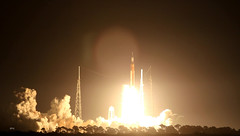| Excursions - NASA Tour |
The brightest night of my life - the start of the Artemis 1
11/17/2022 by Ralf Heckel
Fotos Cosmas blog Rovernauts Launchreports Raumfahrt Concret Werner-Heisenberg-School
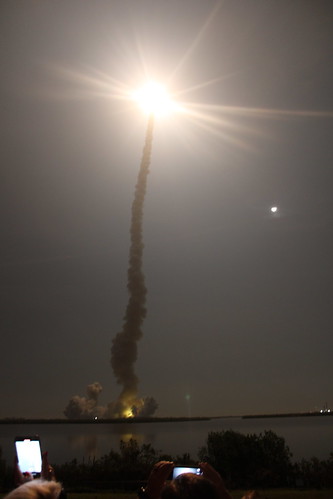 The 8 buses at the boarding area are already waiting with their engines running. The line is still short. Those who still have a badge from the last attempt can queue up straight away, others still have to go to the NASA office on the side. Next to us is ESA astronaut Thomas Pesquet. He flew twice to the ISS with Soyuz and SpaceX's Dragon and spent 396 days in space. Everything goes smoothly. It is already dark and still quite warm at 27 deg C.
The 8 buses at the boarding area are already waiting with their engines running. The line is still short. Those who still have a badge from the last attempt can queue up straight away, others still have to go to the NASA office on the side. Next to us is ESA astronaut Thomas Pesquet. He flew twice to the ISS with Soyuz and SpaceX's Dragon and spent 396 days in space. Everything goes smoothly. It is already dark and still quite warm at 27 deg C.
2 buses in black pull up. They are the VIP buses. They were prepared especially for this day. One has the Artemis logo on it, the other has the rocket printed on it. We are the only ones who dare to get in front of these buses today and take extensive photos. One of them appears the day after on the front page of the Leipzig Times. A better team photo could not be taken in the dark of that night. I've tried a lot, even with a manual wrist-held portable flash, long exposure bursts, and a number of lenses. Nothing came into focus because either someone walked through the picture or Jesco yawned. Bill Ingalls was missing here…
In batches, the queue moves in the direction of the busses. It's a long line behind us now, reaching across the parking lot. We get the bus 346 and after an extensive counting of all guests with a report to the control center, the night begins. You can't see anything because the windows of the buses are darkened for the day trips in bright sunshine. The light is left on inside for this.
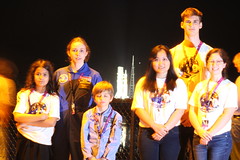 The grandstand at Banana Creek and the parking lot are still empty. The countdown shows T -3:08 hours. We go to the same places as 10 weeks ago and I set up the cameras. The students are busy with their cell phones and our Instagram managers are busy making videos.
The grandstand at Banana Creek and the parking lot are still empty. The countdown shows T -3:08 hours. We go to the same places as 10 weeks ago and I set up the cameras. The students are busy with their cell phones and our Instagram managers are busy making videos.
The SLS rocket is brightly lit on the horizon, quiet and slightly steaming. It is already filled. That's a good sign. Only 3% hydrogen is missing. The flame blazes again behind the launch tower, flaring off the boiling gases at a safe distance. In contrast to the first attempt, all visitors are now relaxed at this sight. A large screen shows the processes on site and moderators explain what is to come. Live broadcasts to all partners from Houston to Bremen show the size of the project.
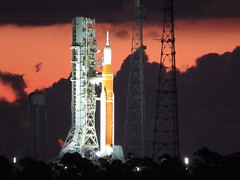
 Then the shock, a leak! The RED TEAM drives with 2 cars directly in front of the steaming and fully fueled rocket. 3 people get out, 2 engineers and a security guard. The engines appear huge and underneath the three of them walk around in white clothes and helmets, climb into the launch tower. What I wouldn't give to be there now, under the steaming and hissing monster that 's about to fly to the moon. One spark and it's all gone. To this day I didn't know that people were allowed to get so close at such a moment. Apparently they are doing their job well. Then the fixed bolt reports a "GO" again. Breathe easy!
Then the shock, a leak! The RED TEAM drives with 2 cars directly in front of the steaming and fully fueled rocket. 3 people get out, 2 engineers and a security guard. The engines appear huge and underneath the three of them walk around in white clothes and helmets, climb into the launch tower. What I wouldn't give to be there now, under the steaming and hissing monster that 's about to fly to the moon. One spark and it's all gone. To this day I didn't know that people were allowed to get so close at such a moment. Apparently they are doing their job well. Then the fixed bolt reports a "GO" again. Breathe easy!
During the last half hour, the countdown remains at -10 minutes. Now the flight director queries all the individual departments and demands a GO. Any answer that is a GO will be applauded and cheered by the audience in our grandstand. One place didn't seem sure about. There was no answer 3 times, until finally the GO could be clearly heard. Big cheers. The restlessness in the audience increases with the excitement.
Everyone here is now aware that they are witnessing a new story. They will later be divided into a before and an after. Many do not yet know what is really behind this first start, which tests are now to follow and what they will influence in the future. Only those in the know here know that this rocket will one day put together an entire space station in lunar orbit and thus form the gateway for permanent bases on the moon.
T -15 seconds, "Free for ELS"
T -10 seconds , "Here we go !”
T -7 seconds, counting backwards and everyone counts , including little Jesco
T -4 seconds, the 4 main engines ignite and go up with a cloud
T -1 second, the main engines run at maximum power
T 0 spark shoots through the Solid Rocket Boosters from above and ignites them,
Now there's no turning back! A shock wave shakes the ground and makes the water rough in Banana Creek.
With a great flash, huge blazing white flames erupt from the two boosters, giving instant boost. Several retaining bolts between the rocket and the launch pad tear through and the rocket lifts off. "We have a liftoff !”
CAM1 CAM2 CAM3 CAM4 CAM5 CAM6 CAM7 CAM8 CAM9
But otherwise everything is still calm. Slowly, the colossus rises with the weight of a 2,800-ton battleship. That's a third of the weight of the Eiffel Tower. The light is getting brighter and blinding. White clouds are spreading at high speed on the right and left of the ground. More than a million liters of cooling water are currently evaporating here. As the rocket exits the launch tower, they swing the main engines away from it. When leaving the tower, the course maneuver begins. But there is no sign of any of this. Onlookers yelled and screamed incessantly, some holding their phones in front of their faces as the rocket picked up speed. It dazzles like a sun and others shield their eyes with their hands.
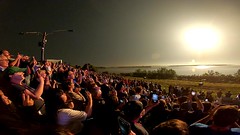
 With a rumble rooaar and a gust of wind, the sound wave from the ignition rolls over us all, 15 seconds later. EARTHQUAKE! At this moment, the rocket has already reached a height of about 10 times its length and it is getting faster and faster. The roar was stifled by the sound that thundered down on us. The gases escape from the engines at hypersonic speed, constantly breaking the sound barrier. This incessant rattling goes through marrow and leg. It becomes deafening and is a sound like hundreds of rapid-firing cannons. The whole body vibrates and the grandstand shakes. The riveted aluminum of this construction rattles at all ends.
With a rumble rooaar and a gust of wind, the sound wave from the ignition rolls over us all, 15 seconds later. EARTHQUAKE! At this moment, the rocket has already reached a height of about 10 times its length and it is getting faster and faster. The roar was stifled by the sound that thundered down on us. The gases escape from the engines at hypersonic speed, constantly breaking the sound barrier. This incessant rattling goes through marrow and leg. It becomes deafening and is a sound like hundreds of rapid-firing cannons. The whole body vibrates and the grandstand shakes. The riveted aluminum of this construction rattles at all ends.
The rocket is now very high. It illuminates the whole of Cape Canaveral as bright as day. You has nearly to close your eyes. The day after, residents of Cocoa , 30 km away, tell me that they have never seen such a bright launch. Their window panes had never shook in such a way.
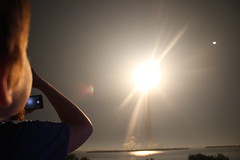
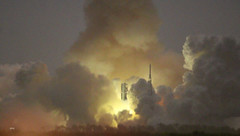 The steam vapor clouds from the 1 million liters of water are still wafting down on the launch site. It's getting dark there now. Only the afterglow of the hot exhaust gases from the SRB 's can be seen in the middle. The aluminum ash that still burned our skin 16 years ago when one of these clouds was carried towards the audience by the wind is glowing yellow and red. This cloud now swirls mystically around the lightning rod, while the surroundings are again shrouded in black and a black column of black smoke, which is slowly becoming longer, points out of it into the sky. At the end, a bright flame flickers like a sparkler. She also emits rays when you squint.
The steam vapor clouds from the 1 million liters of water are still wafting down on the launch site. It's getting dark there now. Only the afterglow of the hot exhaust gases from the SRB 's can be seen in the middle. The aluminum ash that still burned our skin 16 years ago when one of these clouds was carried towards the audience by the wind is glowing yellow and red. This cloud now swirls mystically around the lightning rod, while the surroundings are again shrouded in black and a black column of black smoke, which is slowly becoming longer, points out of it into the sky. At the end, a bright flame flickers like a sparkler. She also emits rays when you squint.
In the meantime, from our position, the Artemis seems to have reached the top. It hangs like a lamp on a huge slender stand of smoke illuminating the entire region. Even the damp air grows light, lighter than the black column of smoke beneath it. But the light grows pale and casts long, sharp shadows. The thunder dies down. The rocket is now just a flickering short dash, seemingly arcing downward, heading straight for the crescent moon lingering below. He is lying on his stomach and seems to want to catch her like an open-topped bowl.
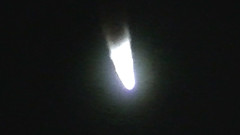
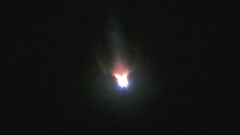 Calmness slowly sets in. Artemis 1 has largely left the atmosphere. It's getting dark fast. Spellbound, everyone looks after the blazing point of light. The comments on the loudspeakers can be understood again. "T + 2 min, SRB- separation " A clapping goes through the group while the point of light in the sky splits into 3 smaller points. The two solid rocket boosters have separated and are moving away from the center. This one is just very weak. These are the 4 main engines that already provided the thrust for the Space Shuttle and now accelerate the emptying rocket to maximum thrust. This is now followed by 6 minutes of quiet but steadily increasing acceleration and loading up to 3G. The structure of the emptying tanks in the main engine block now groans with strain. The spaceship "Orion" sits at the top of the tube. If the astronaut Helga in there wasn't a dummy, she would now have long cheeks and be happy. This is where the formula from physics lessons materializes: F=m*a (force equals mass by acceleration). The mass decreases with rapidly emptying tanks and with the same full load thrust the acceleration increases congruently.
Calmness slowly sets in. Artemis 1 has largely left the atmosphere. It's getting dark fast. Spellbound, everyone looks after the blazing point of light. The comments on the loudspeakers can be understood again. "T + 2 min, SRB- separation " A clapping goes through the group while the point of light in the sky splits into 3 smaller points. The two solid rocket boosters have separated and are moving away from the center. This one is just very weak. These are the 4 main engines that already provided the thrust for the Space Shuttle and now accelerate the emptying rocket to maximum thrust. This is now followed by 6 minutes of quiet but steadily increasing acceleration and loading up to 3G. The structure of the emptying tanks in the main engine block now groans with strain. The spaceship "Orion" sits at the top of the tube. If the astronaut Helga in there wasn't a dummy, she would now have long cheeks and be happy. This is where the formula from physics lessons materializes: F=m*a (force equals mass by acceleration). The mass decreases with rapidly emptying tanks and with the same full load thrust the acceleration increases congruently.
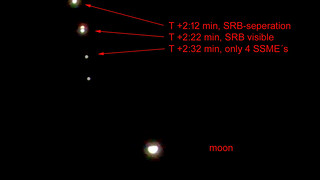 The atmosphere in the stands dissolves into appreciative and astonished tones. All lights are off so we can track the slowly receding spot. He flies past the moon to the left and heads down towards the horizon. Not much happens with the comments. The big screen is off to enjoy the moment. Now clap again. The main stage has been successfully separated. The dot goes out. Now the cruise engines of block 3 ignite. But that is only one engine and this flame can no longer be seen.
The atmosphere in the stands dissolves into appreciative and astonished tones. All lights are off so we can track the slowly receding spot. He flies past the moon to the left and heads down towards the horizon. Not much happens with the comments. The big screen is off to enjoy the moment. Now clap again. The main stage has been successfully separated. The dot goes out. Now the cruise engines of block 3 ignite. But that is only one engine and this flame can no longer be seen.
Our students still can't believe it. Sakurako has her hands on her face and looks through her spread fingers as if she wants to stay in the old days for a while. "Wow", " Amazing ", "Awesome" are the words I hear more and more now. The lighting is switched on again.
 Welcome new world! The 2nd lunar age has begun and we were the only ones of our countries and ages to be there. Up to Artemis 2, we will carry this experience and its message to schools around the world with these 6 students as part of several world trips and help shape the multinational Artemis-Generation.
Welcome new world! The 2nd lunar age has begun and we were the only ones of our countries and ages to be there. Up to Artemis 2, we will carry this experience and its message to schools around the world with these 6 students as part of several world trips and help shape the multinational Artemis-Generation.
There will also be a new young talent competition in Europe, which is politically more independent, more future-oriented and multinationally more balanced than anything we have been able to get to know and help shape so far.
Team Attempt 1-2 (September 2022):
Jesco Heckel (8), Primary School, Germany
Tara Heckel (13), Secondyry School, Germany
Arthur Sommer (17), Highschool, Germany
Cosma Heckel (15), Highschool, Germany
Sakurako Kuba (27), Embry Riddle University, Japan
Valeria Vazquez Zafra (24), Tesla, Mexico
Abaham Vega (21), Tec Cuernavaca, Mexico
Ian Doring (19), Tec Cuernavaca, Mexico
Jorge Emiliano Turner Escalante (20), Tec Cuernavaca, Mexico
Sebastian Cruz (22), Tec Cuernavaca, Mexico
Daniela Espinosa (20), Tec Cuernavaca, Mexico
Team Launch:
Jesco Heckel (8), Primary School, Germany
Sakurako Kuba (27), Embry Riddle University, Japan
Valencia Jaco (11), Secondyry School, USA
Valeria Vazquez Zafra (24), Tesla, Mexico
Arthur Sommer (17), Highschool, Germany
Cosma Heckel (15), Highschool, Germany
special thanks to:
Yvonne & Ralf Heckel (spaceeducation.de)
David Suarez, Tec Cuernavaca, Mexico
Prof. Dr.Jesco von Puttkamer (1933-2012)
Dr. Alotta Taylor (NASA-HQ)
Shera McNeill (NASA-HQ)
James Free (NASA)
Barbara Zelon (NASA)
William (Bill) Readdy (Discovery Partners)
thanks to our sponsors:
Space Hotel Leipzig
Beachside Hotel & Suits, Cocoa Beach
Motel 6, Cocoa Beach
Gregorys Steak & Seafood, Cocoa Beach
Weblinks:
more Fotos: https://www.flickr.com/photos/spaceeducation/collections/72157721010554041/
more videos: (playlist Artemis 1)
Facebook: https://www.facebook.com/International.Space.Education.Institute/
Instagram: https://instagram.com/rovernauts?igshid=YmMyMTA2M2Y=
Rovernauts-Blog: https://www.facebook.com/rovernauts/
Student Space Blog: https://www.spaceeducation.de/en/student-reports/89-2022-artemis-1.html?layout=default
Press:
- Leipziger Volkszeitung
- Raumfahrt Concret
This educational travel and excursion was managed by International Space Education Institute Leipzig/Germany.
| Next > |
|---|

































